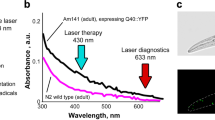Abstract
Amyloid fibrils are causal substances for serious neurodegenerative disorders and amyloidosis. Among them, polyglutamine fibrils seen in multiple polyglutamine diseases are toxic to neurons. Although much efforts have been made to explore the treatments of polyglutamine diseases, there are no effective drugs to block progression of the diseases. We recently found that a free electron laser (FEL), which has an oscillation wavelength at the amide I band (C = O stretch vibration mode) and picosecond pulse width, was effective for conversion of the fibril forms of insulin, lysozyme, and calcitonin peptide into their monomer forms. However, it is not known if that is also the case in polyglutamine fibrils in cells. We found in this study that the fibril-specific β-sheet conformation of polyglutamine peptide was converted into nonfibril form, as evidenced by the infrared microscopy and scanning-electron microscopy after the irradiation tuned to 6.08 μm. Furthermore, irradiation at this wavelength also changed polyglutamine fibrils to their nonfibril state in cultured cells, as shown by infrared mapping image of protein secondary structure. Notably, infrared thermography analysis showed that temperature increase of the cells during the irradiation was within 1 K, excluding thermal damage of cells. These results indicate that the picosecond pulsed infrared laser can safely reduce amyloid fibril structure to the nonfibril form even in cells.





Similar content being viewed by others
Abbreviations
- DMSO:
-
Dimethyl sulfoxide
- FEL:
-
Free electron laser
- IRM:
-
Infrared microscopy
- OM:
-
Optical microscopy
- PBS:
-
Phosphate-buffered saline
- SCA:
-
Spinocerebellar ataxia
- SEM:
-
Scanning electron microscopy
- TAMRA:
-
Tetra-methyl rhodamine
References
Sipe JD, Benson MD, Buxbaum JN, Ikeda S, Merlini G, Saraiva MJM, Westermark P (2014) Nomenclature 2014: amyloid fibril proteins and clinical classification of the amyloidosis. Amyloid 21:221–224
Nakamura K, Mieda T, Suto N, Matsuura S, Hirai H (2015) Mesenchymal stem cells as a potential therapeutic tool for spinocerebellar ataxia. Cerebellum 14:165–170
Jacobsen H, Ozmen L, Caruso A, Narquizian R, Hilpert H, Jacobsen B, Terwel D, Tanghe A, Bohrmann B (2014) Combined treatment with a BACE inhibitor and anti-Aβ antibody Gantenerumab enhances amyloid reduction in APPLondon mice. J Neurosci 34:11621–11630
Hutson MS, Ivanov B, Jayasinghe A, Adunas G, Xiao Y, Guo M, Kozub J (2009) Interplay of wavelength, fluence and spot-size in free-electron laser ablation of cornea. Opt Express 17:9840–9850
Kawasaki T, Fujioka J, Imai T, Tsukiyama K (2012) Effect of mid-infrared free-electron laser irradiation on refolding of amyloid-like fibrils of lysozyme into native form. Protein J 31:710–716
Kawasaki T, Fujioka J, Imai T, Torigoe K, Tsukiyama K (2014) Mid-infrared free-electron laser tuned to the amide I band for converting insoluble amyloid-like protein fibrils into the soluble monomeric form. Lasers Med Sci 29:1701–1707
Kawasaki T, Imai T, Tsukiyama K (2014) Use of a mid-infrared free-electron laser (MIR-FEL) for dissociation of the amyloid fibril aggregates of a peptide. J Anal Sci Meth Instrum 4:9–18
Kawasaki T, Yaji T, Imai T, Ohta T, Tsukiyama K (2014) Synchrotron-infrared microscopy analysis of amyloid fibrils irradiated by mid-infrared free-electron laser. Am J Anal Chem 5:384–394
Kawasaki T, Yaji T, Ohta T, Tsukiyama K (2016) Application of mid-infrared free-electron laser tuned to amide bands for dissociation of aggregate structure of protein. J Synchrotron Rad 23:152–157
Sarver RW Jr, Krueger WC (1991) Protein secondary structure from Fourier transform infrared spectroscopy: a data base analysis. Anal Biochem 194:89–100
Caine S, Heraud P, Tobin MJ, McNaughton D, Bernard CCA (2012) The application of Fourier transform infrared microspectroscopy for the study of diseased central nervous system tissue. NeuroImage 59:3624–3640
Anderson RR, Parrish JA (1983) Selective photothermolysis: precise microsurgery by selective absorption of pulsed radiation. Science 220:524–527
Amini-Nik S, Kraemer D, Cowan ML, Gunaratne K, Nadesan P, Alman BA, Miller RJ (2010) Ultrafast mid-IR laser scalpel: protein signals of the fundamental limits to minimally invasive surgery. PLoS ONE 5:e13053
Viet MH, Truong PM, Derreumaux P, Li MS, Roland C, Sagui C, Nguyen PH (2015) Picosecond melting of peptide nanotubes using an infrared laser: a nonequilibrium simulation study. Phys Chem Chem Phys 17:27275–27280
Viet MH, Derreumaux P, Li MS, Roland C, Sagui C, Nguyen PH (2015) Picosecond dissociation of amyloid fibrils with infrared laser: a nonequilibrium simulation study. J Chem Phys 143:155101
Acknowledgments
We are grateful to the staff of IR-FEL Research Center at Tokyo University of Science for kindly providing the beam time. This work was supported in part by the Open Advanced Research Facilities Initiative and Photon Beam Platform Project of the Ministry of Education, Culture, Sport, Science and Technology, Japan
Author information
Authors and Affiliations
Corresponding author
Rights and permissions
About this article
Cite this article
Kawasaki, T., Ohori, G., Chiba, T. et al. Picosecond pulsed infrared laser tuned to amide I band dissociates polyglutamine fibrils in cells. Lasers Med Sci 31, 1425–1431 (2016). https://doi.org/10.1007/s10103-016-2004-x
Received:
Accepted:
Published:
Issue Date:
DOI: https://doi.org/10.1007/s10103-016-2004-x




